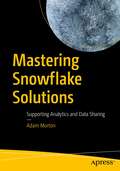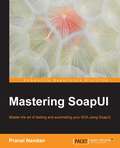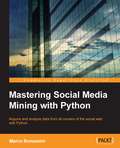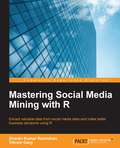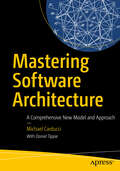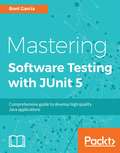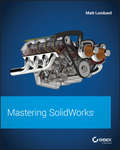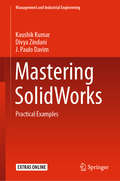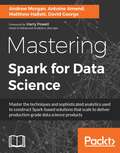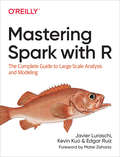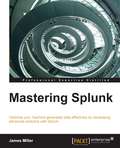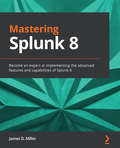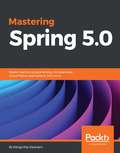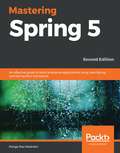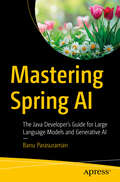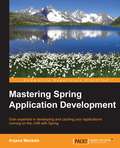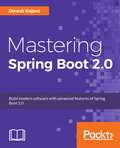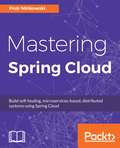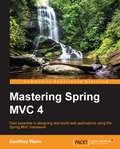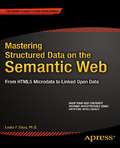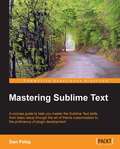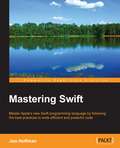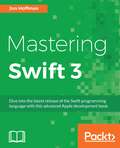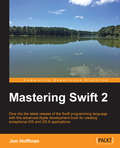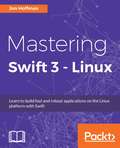- Table View
- List View
Mastering Snowflake Solutions: Supporting Analytics and Data Sharing
by Adam MortonDesign for large-scale, high-performance queries using Snowflake’s query processing engine to empower data consumers with timely, comprehensive, and secure access to data. This book also helps you protect your most valuable data assets using built-in security features such as end-to-end encryption for data at rest and in transit. It demonstrates key features in Snowflake and shows how to exploit those features to deliver a personalized experience to your customers. It also shows how to ingest the high volumes of both structured and unstructured data that are needed for game-changing business intelligence analysis. Mastering Snowflake Solutions starts with a refresher on Snowflake’s unique architecture before getting into the advanced concepts that make Snowflake the market-leading product it is today. Progressing through each chapter, you will learn how to leverage storage, query processing, cloning, data sharing, and continuous data protection features. This approach allows for greater operational agility in responding to the needs of modern enterprises, for example in supporting agile development techniques via database cloning. The practical examples and in-depth background on theory in this book help you unleash the power of Snowflake in building a high-performance system with little to no administrative overhead. Your result from reading will be a deep understanding of Snowflake that enables taking full advantage of Snowflake’s architecture to deliver value analytics insight to your business. What You Will LearnOptimize performance and costs associated with your use of the Snowflake data platformEnable data security to help in complying with consumer privacy regulations such as CCPA and GDPRShare data securely both inside your organization and with external partnersGain visibility to each interaction with your customers using continuous data feeds from SnowpipeBreak down data silos to gain complete visibility your business-critical processesTransform customer experience and product quality through real-time analyticsWho This Book Is forData engineers, scientists, and architects who have had some exposure to the Snowflake data platform or bring some experience from working with another relational database. This book is for those beginning to struggle with new challenges as their Snowflake environment begins to mature, becoming more complex with ever increasing amounts of data, users, and requirements. New problems require a new approach and this book aims to arm you with the practical knowledge required to take advantage of Snowflake’s unique architecture to get the results you need.
Mastering SoapUI
by Pranai NandanMaster the art of testing and automating your SOA using SoapUI About This Book * Design real-time test automation frameworks for Enterprise applications using SoapUI * Learn how to solve test automation issues for complex systems * A complete guide to understanding SOA automation from quality assurance to business assurance Who This Book Is For The book is intended for test architects, SOA test specialists, automation testers, test managers, and software developers who have a good understanding of SOA, web services, Groovy Scripting, and the SOAP UI tool. What You Will Learn * Familiarize yourself with Test Web services from functional, nonfunctional, and security aspects * Learn to test real-time service orchestrations * Design test automation solutions for SOA-based Enterprise applications * Learn multilayer test automation * Selenium plus SoapUI under a single umbrella * Integrate your SoapUI framework with Jenkins In Detail SoapUI is an open-source cross-platform testing application that provides complete test coverage and supports all the standard protocols and technologies. This book includes real-time examples of implementing SoapUI to achieve quality and business assurance. Starting with the features and functionalities of SoapUI, the book will then focus on functional testing, load testing, and security testing of web services. Furthermore, you will learn how to automate your services and then design data-driven, keyword-driven, and hybrid-driven frameworks in SoapUI. Then the book will show you how to test UIs and services using SoapUI with the help of Selenium. You will also learn how to integrate SoapUI with Jenkins for CI and SoapUI test with QC with backward- and forward-compatibility. The final part of the book will show you how to virtualize a service response in SoapUI using Service Mocking. You will finish the journey by discovering the best practices for SoapUI test automation and preparing yourself for the online certification of SoapUI. Style and approach Filled with real-time examples, this book will help readers take their knowledge to the next level. This book is a comprehensive guide that will cover the end-to-end life cycle of implementing SoapUI in various phases of software testing and the software development life cycle.
Mastering Social Media Mining with Python
by Marco BonzaniniAcquire and analyze data from all corners of the social web with Python About This Book * Make sense of highly unstructured social media data with the help of the insightful use cases provided in this guide * Use this easy-to-follow, step-by-step guide to apply analytics to complicated and messy social data * This is your one-stop solution to fetching, storing, analyzing, and visualizing social media data Who This Book Is For This book is for intermediate Python developers who want to engage with the use of public APIs to collect data from social media platforms and perform statistical analysis in order to produce useful insights from data. The book assumes a basic understanding of the Python Standard Library and provides practical examples to guide you toward the creation of your data analysis project based on social data. What You Will Learn * Interact with a social media platform via their public API with Python * Store social data in a convenient format for data analysis * Slice and dice social data using Python tools for data science * Apply text analytics techniques to understand what people are talking about on social media * Apply advanced statistical and analytical techniques to produce useful insights from data * Build beautiful visualizations with web technologies to explore data and present data products In Detail Your social media is filled with a wealth of hidden data - unlock it with the power of Python. Transform your understanding of your clients and customers when you use Python to solve the problems of understanding consumer behavior and turning raw data into actionable customer insights. This book will help you acquire and analyze data from leading social media sites. It will show you how to employ scientific Python tools to mine popular social websites such as Facebook, Twitter, Quora, and more. Explore the Python libraries used for social media mining, and get the tips, tricks, and insider insight you need to make the most of them. Discover how to develop data mining tools that use a social media API, and how to create your own data analysis projects using Python for clear insight from your social data. Style and approach This practical, hands-on guide will help you learn everything you need to perform data mining for social media. Throughout the book, we take an example-oriented approach to use Python for data analysis and provide useful tips and tricks that you can use in day-to-day tasks.
Mastering Social Media Mining with R
by Sharan Kumar Ravindran Vikram GargExtract valuable data from your social media sites and make better business decisions using R About This Book * Explore the social media APIs in R to capture data and tame it * Employ the machine learning capabilities of R to gain optimal business value * A hands-on guide with real-world examples to help you take advantage of the vast opportunities that come with social media data Who This Book Is For If you have basic knowledge of R in terms of its libraries and are aware of different machine learning techniques, this book is for you. Those with experience in data analysis who are interested in mining social media data will find this book useful. What You Will Learn * Access APIs of popular social media sites and extract data * Perform sentiment analysis and identify trending topics * Measure CTR performance for social media campaigns * Implement exploratory data analysis and correlation analysis * Build a logistic regression model to detect spam messages * Construct clusters of pictures using the K-means algorithm and identify popular personalities and destinations * Develop recommendation systems using Collaborative Filtering and the Apriori algorithm In Detail With an increase in the number of users on the web, the content generated has increased substantially, bringing in the need to gain insights into the untapped gold mine that is social media data. For computational statistics, R has an advantage over other languages in providing readily-available data extraction and transformation packages, making it easier to carry out your ETL tasks. Along with this, its data visualization packages help users get a better understanding of the underlying data distributions while its range of "standard" statistical packages simplify analysis of the data. This book will teach you how powerful business cases are solved by applying machine learning techniques on social media data. You will learn about important and recent developments in the field of social media, along with a few advanced topics such as Open Authorization (OAuth). Through practical examples, you will access data from R using APIs of various social media sites such as Twitter, Facebook, Instagram, GitHub, Foursquare, LinkedIn, Blogger, and other networks. We will provide you with detailed explanations on the implementation of various use cases using R programming. With this handy guide, you will be ready to embark on your journey as an independent social media analyst. Style and approach This easy-to-follow guide is packed with hands-on, step-by-step examples that will enable you to convert your real-world social media data into useful, practical information.
Mastering Software Architecture: A Comprehensive New Model and Approach
by Michael CarducciAs the pace of evolution in technology continues to accelerate, the field of software architecture grapples with ever-increasing complexity, uncertainty, and risk. While numerous patterns and practices have emerged as potential approaches to solving the industry’s most challenging problems, these tools often struggle to consistently deliver on their promises and software projects fail to reach their potential with alarming frequency. This meticulously crafted guide presents a deep exploration into the intricacies of crafting systems that precisely and predictably address modern challenges. It goes beyond mere comprehension of architecture; it encourages mastery. Mastery of software architecture requires much more than just technical know-how. The author, drawing upon deep experience and unique perspectives, introduces a fresh, problem-centric approach to the realm of software architecture to address these myriad challenges. This book offers a uniquely holistic approach, weaving together architectural principles with organizational dynamics, environmental subtleties, and the necessary tools to execute on architecture more effectively. It addresses the broader contexts that are often overlooked. You’ll be introduced to the transformative Tailor-Made model which provides fast, design-time feedback on total architectural fit and offers more deterministic outcomes, without the typical (and costly) trial-and-error. The Tailor-Made model further enables a practical approach to designing evolutionary architectures. This book also offers a comprehensive Architect's toolbox with powerful strategies and problem-solving tools to design, communicate, and implement architectural decisions across the enterprise. Additionally, it imparts invaluable insights into the art of communication as an architect, seamlessly aligning visions with business goals and objectives. With its rich blend of theoretical depth, practical insights, and actionable tools, this book promises to redefine the landscape of software architecture. Whether you are an established architect or an aspiring one, Mastering Software Architecture is poised to enhance your expertise, enabling you to confront architectural challenges with unparalleled confidence and competence. What You will Learn Discover a comprehensive set of concepts, tools, models, and practices that enhance the fit and reduce uncertainty in software architecture. Quantify and measure the impact of architectural decisions, providing a clear and actionable approach to architecture. Effectively apply the model in diverse situations and environments, while overcoming the otherwise-limiting organizational realities. Communicate architecture effectively to both business and technical teams, build consensus, engender buy-in, and lead change across the organization. Who This Book Is For Aspiring architects looking to broaden their horizons, practicing architects seeking to continue to grow their skills, and software engineers looking to gain insights and move up the value chain in an increasingly competitive market.
Mastering Software Testing with JUnit 5
by Boni GarciaA comprehensive, hands-on guide on unit testing framework for Java programming language About This Book • In-depth coverage of Jupiter, the new programming and extension model provided by JUnit 5 • Integration of JUnit 5 with other frameworks such as Mockito, Spring, Selenium, Cucumber, and Docker • Best practices for writing meaningful Jupiter test cases Who This Book Is For This book is for Java software engineers and testers. If you are a Java developer who is keen on improving the quality of your code and building world class applications then this book is for you. Prior experience of the concepts of automated testing will be helpful. What You Will Learn • The importance of software testing and its impact on software quality • The options available for testing Java applications • The architecture, features and extension model of JUnit 5 • Writing test cases using the Jupiter programming model • How to use the latest and advanced features of JUnit 5 • Integrating JUnit 5 with existing third-party frameworks • Best practices for writing meaningful JUnit 5 test cases • Managing software testing activities in a living software project In Detail When building an application it is of utmost importance to have clean code, a productive environment and efficient systems in place. Having automated unit testing in place helps developers to achieve these goals. The JUnit testing framework is a popular choice among Java developers and has recently released a major version update with JUnit 5. This book shows you how to make use of the power of JUnit 5 to write better software. The book begins with an introduction to software quality and software testing. After that, you will see an in-depth analysis of all the features of Jupiter, the new programming and extension model provided by JUnit 5. You will learn how to integrate JUnit 5 with other frameworks such as Mockito, Spring, Selenium, Cucumber, and Docker. After the technical features of JUnit 5, the final part of this book will train you for the daily work of a software tester. You will learn best practices for writing meaningful tests. Finally, you will learn how software testing fits into the overall software development process, and sits alongside continuous integration, defect tracking, and test reporting. Style and approach The book offers definitive and comprehensive coverage of all the Unit testing concepts with JUnit and its features using several real world examples so that readers can put their learning to practice almost immediately. This book is structured in three parts: 1. Software testing foundations (software quality and Java testing) 2. JUnit 5 in depth (programming and extension model of JUnit 5) 3. Software testing in practice (how to write and manage JUnit 5 tests)
Mastering SolidWorks
by Matt LombardThe complete SolidWorks reference-tutorial for beginner to advanced techniques Mastering SolidWorks is the reference-tutorial for all users. Packed with step-by-step instructions, video tutorials for over 40 chapters, and coverage of little-known techniques, this book takes you from novice to power user with clear instruction that goes beyond the basics. Fundamental techniques are detailed with real-world examples for hands-on learning, and the companion website provides tutorial files for all exercises. Even veteran users will find value in new techniques that make familiar tasks faster, easier, and more organized, including advanced file management tools that simplify and streamline pre-flight checks. SolidWorks is the leading 3D CAD program, and is an essential tool for engineers, mechanical designers, industrial designers, and drafters around the world. User friendly features such as drag-and-drop, point-and-click, and cut-and-paste tools belie the software’s powerful capabilities that can help you create cleaner, more precise, more polished designs in a fraction of the time. This book is the comprehensive reference every SolidWorks user needs, with tutorials, background, and more for beginner to advanced techniques. Get a grasp on fundamental SolidWorks 2D and 3D tasks using realistic examples with text-based tutorials Delve into advanced functionality and capabilities not commonly covered by how-to guides Incorporate improved search, Pack-and-Go and other file management tools into your workflow Adopt best practices and exclusive techniques you won’t find anywhere else Work through this book beginning-to-end as a complete SolidWorks course, or dip in as needed to learn new techniques and time-saving tricks on-demand. Organized for efficiency and designed for practicality, these tips will remain useful at any stage of expertise. With exclusive coverage and informative detail, Mastering SolidWorks is the tutorial-reference for users at every level of expertise.
Mastering SolidWorks: Practical Examples (Management and Industrial Engineering)
by J. Paulo Davim Kaushik Kumar Divya ZindaniThis book provides the reader with a comprehensive knowledge of all the tools provided in the software SOLIDWORKS for a variety of engineering areas. It presents a broad choice of examples to be imitated in one’s own work. In developing these examples, the authors’ intent has been to exercise many program features and refinements. By displaying these, the authors hope to give readers the confidence to employ these program enhancements in their own modeling applications.
Mastering Spark for Data Science
by David George Andrew Morgan Antoine Amend Matthew HallettMaster the techniques and sophisticated analytics used to construct Spark-based solutions that scale to deliver production-grade data science products About This Book • Develop and apply advanced analytical techniques with Spark • Learn how to tell a compelling story with data science using Spark's ecosystem • Explore data at scale and work with cutting edge data science methods Who This Book Is For This book is for those who have beginner-level familiarity with the Spark architecture and data science applications, especially those who are looking for a challenge and want to learn cutting edge techniques. This book assumes working knowledge of data science, common machine learning methods, and popular data science tools, and assumes you have previously run proof of concept studies and built prototypes. What You Will Learn • Learn the design patterns that integrate Spark into industrialized data science pipelines • See how commercial data scientists design scalable code and reusable code for data science services • Explore cutting edge data science methods so that you can study trends and causality • Discover advanced programming techniques using RDD and the DataFrame and Dataset APIs • Find out how Spark can be used as a universal ingestion engine tool and as a web scraper • Practice the implementation of advanced topics in graph processing, such as community detection and contact chaining • Get to know the best practices when performing Extended Exploratory Data Analysis, commonly used in commercial data science teams • Study advanced Spark concepts, solution design patterns, and integration architectures • Demonstrate powerful data science pipelines In Detail Data science seeks to transform the world using data, and this is typically achieved through disrupting and changing real processes in real industries. In order to operate at this level you need to build data science solutions of substance –solutions that solve real problems. Spark has emerged as the big data platform of choice for data scientists due to its speed, scalability, and easy-to-use APIs. This book deep dives into using Spark to deliver production-grade data science solutions. This process is demonstrated by exploring the construction of a sophisticated global news analysis service that uses Spark to generate continuous geopolitical and current affairs insights.You will learn all about the core Spark APIs and take a comprehensive tour of advanced libraries, including Spark SQL, Spark Streaming, MLlib, and more. You will be introduced to advanced techniques and methods that will help you to construct commercial-grade data products. Focusing on a sequence of tutorials that deliver a working news intelligence service, you will learn about advanced Spark architectures, how to work with geographic data in Spark, and how to tune Spark algorithms so they scale linearly. Style and approach This is an advanced guide for those with beginner-level familiarity with the Spark architecture and working with Data Science applications. Mastering Spark for Data Science is a practical tutorial that uses core Spark APIs and takes a deep dive into advanced libraries including: Spark SQL, visual streaming, and MLlib. This book expands on titles like: Machine Learning with Spark and Learning Spark. It is the next learning curve for those comfortable with Spark and looking to improve their skills.
Mastering Spark with R: The Complete Guide to Large-Scale Analysis and Modeling
by Javier Luraschi Kevin Kuo Edgar RuizIf you’re like most R users, you have deep knowledge and love for statistics. But as your organization continues to collect huge amounts of data, adding tools such as Apache Spark makes a lot of sense. With this practical book, data scientists and professionals working with large-scale data applications will learn how to use Spark from R to tackle big data and big compute problems.Authors Javier Luraschi, Kevin Kuo, and Edgar Ruiz show you how to use R with Spark to solve different data analysis problems. This book covers relevant data science topics, cluster computing, and issues that should interest even the most advanced users.Analyze, explore, transform, and visualize data in Apache Spark with RCreate statistical models to extract information and predict outcomes; automate the process in production-ready workflowsPerform analysis and modeling across many machines using distributed computing techniquesUse large-scale data from multiple sources and different formats with ease from within SparkLearn about alternative modeling frameworks for graph processing, geospatial analysis, and genomics at scaleDive into advanced topics including custom transformations, real-time data processing, and creating custom Spark extensions
Mastering Splunk
by James MillerThis book is for those Splunk developers who want to learn advanced strategies to deal with big data from an enterprise architectural perspective. You need to have good working knowledge of Splunk.
Mastering Splunk 8: Become an expert at implementing the advanced features and capabilities of Splunk 8
by James D. MillerDelve into Splunk and extend intelligence capabilities, and leverage machine learning to explore data efficientlyKey FeaturesGain the expertise you need to implement the advanced features and capabilities of Splunk 8Get to grips with advanced Splunk features and create compelling reports and dashboardsDevelop and manage advanced Splunk pipelines to integrate intelligence capabilities within your organizationBook DescriptionSplunk is the most widely used engine for working with machine-generated data. This expert-level guide will help you to leverage advanced use cases to drive business growth using operational intelligence and business analytics features. You'll start with an introduction to the new features in Splunk 8 and cover step-by-step exercises that will help you to understand each feature in depth. Next, you'll explore key tasks such as workload management, performance and alerting, Splunk Enterprise Security, and advanced indexing. You'll also learn how to create categorical charts and run analytical operations on metrics within the Splunk Analytics workspace, before understanding how to deliver insights across your organization even when faced with limited or complex data using advanced data analytics. The book will also show you how to monitor and maintain Splunk environments using advanced dashboards. Later, you'll create custom data visualizations and update dashboards using drag and drop and the UI-based dashboard editor. Finally, you'll add SplunkJS to a web app and use the Splunk Machine Learning Toolkit (MLTK) as an extension to the core Splunk platform using real-world use cases. By the end of this book, you'll have learned how to use various Splunk features to extend intelligence capabilities and perform machine learning to explore data effectively.What you will learnUnderstand the components of Splunk 8 and how they workConvert distributed search environments to clusters and configure disaster recovery sites using index clusteringFind out how to integrate Splunk with platforms such as AWS and Microsoft AzureUse Search Processing Language (SPL) within Splunk macros to create efficient searchingDetect suspicious patterns in data with advanced event correlation searchesExplore machine learning with Splunk MLTKReview the beta dashboard editor using working examplesUse SplunkJS Stack libraries to enhance web appsWho this book is forThis Splunk book is for data professionals, data analysts, and Splunk users looking to leverage the advanced features of the Splunk Enterprise platform to derive valuable business insights from machine data. The book is also a useful expert-level guide for individuals from all facets of IT, business, and security. Prior knowledge of Splunk and its features is mandatory to get the most out of this book.
Mastering Spring 5.0
by Ranga Rao KaranamDevelop cloud native applications with microservices using Spring Boot, Spring Cloud, and Spring Cloud Data Flow About This Book • Explore the new features and components in Spring • Evolve towards micro services and cloud native applications • Gain powerful insights into advanced concepts of Spring and Spring Boot to develop applications more effectively • Understand the basics of Kotlin and use it to develop a quick service with Spring Boot Who This Book Is For This book is for an experienced Java developer who knows the basics of Spring, and wants to learn how to use Spring Boot to build applications and deploy them to the cloud. What You Will Learn • Explore the new features in Spring Framework 5.0 • Build microservices with Spring Boot • Get to know the advanced features of Spring Boot in order to effectively develop and monitor applications • Use Spring Cloud to deploy and manage applications on the Cloud • Understand Spring Data and Spring Cloud Data Flow • Understand the basics of reactive programming • Get to know the best practices when developing applications with the Spring Framework • Create a new project using Kotlin and implement a couple of basic services with unit and integration testing In Detail Spring 5.0 is due to arrive with a myriad of new and exciting features that will change the way we've used the framework so far. This book will show you this evolution—from solving the problems of testable applications to building distributed applications on the cloud. The book begins with an insight into the new features in Spring 5.0 and shows you how to build an application using Spring MVC. You will realize how application architectures have evolved from monoliths to those built around microservices. You will then get a thorough understanding of how to build and extend microservices using Spring Boot. You will also understand how to build and deploy Cloud-Native microservices with Spring Cloud. The advanced features of Spring Boot will be illustrated through powerful examples. We will be introduced to a JVM language that's quickly gaining popularity - Kotlin. Also, we will discuss how to set up a Kotlin project in Eclipse. By the end of the book, you will be equipped with the knowledge and best practices required to develop microservices with the Spring Framework. Style and Approach This book follows an end-to-end tutorial approach with lots of examples and sample applications, covering the major building blocks of the Spring framework.
Mastering Spring 5: An effective guide to build enterprise applications using Java Spring and Spring Boot framework, 2nd Edition
by Ranga Rao KaranamBuild scalable and flexible Rest APIs and microservices using the latest versions of Spring and Spring Boot Key Features Build Java-based enterprise applications using Spring 5.1 and Spring Boot 2.1 Create high performing, reusable, and scalable enterprise Java applications that are easy to test Gain powerful insights into advanced Spring and Spring Boot concepts to develop applications effectively Book Description Spring 5.1 is the latest release of the widely used Spring Framework. This book takes you through the evolution of building enterprise-ready applications with Spring and Spring Boot. Mastering Spring 5 starts with an overview of some of the important Spring Framework features relating to aspect-oriented programming, task scheduling, and scripting with the help of practical examples. You'll learn about the standard dependency injection specification for Java contexts and CDI and how the Spring Framework supports it. You'll gain an understanding of how application architectures have evolved from monoliths to microservices and be able to build your own microservices using Spring Boot. Complete with real-world examples, this book will help you gain powerful insights into Spring Boot 2.1 and learn how to develop cloud-native microservices with Spring Cloud. You'll even explore how to secure a REST API with Spring Security and get started with your first full stack application using React. Furthermore, you'll get to grips with Kotlin fundamentals and build a Kotlin project in Eclipse. By the end of this book, you'll be equipped with all the knowledge required to develop microservices and full stack applications with the Spring Framework. What you will learn Explore Spring Framework 5.1 features such as AOP, transaction management, task scheduling, and scripting Build REST APIs and microservices with Spring and Spring Boot Develop a secure REST API with Spring Security Build your first full stack React application Write efficient unit tests with Spring and Spring Boot Understand the advanced features that Spring Boot offers to develop and monitor applications Use Spring Cloud to deploy and manage applications on the Cloud Who this book is for This book is for experienced Java and enterprise Java developers and programmers who have a basic understanding of the Spring Framework.
Mastering Spring AI: The Java Developer’s Guide for Large Language Models and Generative AI
by Banu ParasuramanDive into the future of programming with this comprehensive guide for Java developers to integrate large language models (LLMs) and Generative AI using the Spring Framework. This book comes at a revolutionary time when AI technology is transforming how we implement solutions in various fields, including natural language processing, content generation, and predictive analytics. With its widespread use in the Java community, the Spring Framework is a logical choice for this integration. By focusing on integrating LLMs and GenAI with Spring, this book bridges a significant gap between cutting-edge AI technologies and traditional Java development practices. The author uses a hands-on approach, guiding you through practical implementation to effectively show how to apply theory in real-world situations. Basic introductions of topics—Spring AI, Spring Framework, and other related AI technologies—evolve into advanced integrations to ensure that you find valuable insights regardless of your starting level. Additionally, this book dedicates sections to security and ethical considerations, addressing the pressing issues associated with AI. With a look at emerging trends and future developments, this book prepares you for what's next, ensuring that you are not just catching up with the current state of technology but are also ready for future advancements. What You Will Learn • Master the integration of LLMs and GenAI with the Spring Framework • Develop practical skills in developing AI-driven applications using Java • Gain insights into handling data, security, and ethical considerations in AI applications • Apply strategies for optimizing performance and scalability in AI-enabled applications • Prepare for future AI trends and technologies Who This Book Is For Intermediate to advanced Java developers who are familiar with the Spring Framework, including concepts such as dependency injection, Spring Boot, and building RESTful services. This foundational knowledge will help developers grasp the more advanced topics of integrating AI technologies with Spring. Prior knowledge of basic AI concepts and machine learning is helpful but not essential as the book covers these topics from the ground up.
Mastering Spring Application Development
by Anjana MankaleIf you are a Java developer with experience in developing applications with Spring, then this book is perfect for you. A good working knowledge of Spring programming conventions and applying dependency injections is recommended to make the most of this book.
Mastering Spring Boot 2.0: Build modern, cloud-native, and distributed systems using Spring Boot
by Dinesh RajputLearn to develop, test, and deploy your Spring Boot distributed application and explore various best practices.Key Features- Build and deploy your microservices architecture in the cloud- Build event-driven resilient systems using Hystrix and Turbine- Explore API management tools such as KONG and API documentation tools such as SwaggerBook DescriptionSpring is one of the best frameworks on the market for developing web, enterprise, and cloud ready software. Spring Boot simplifies the building of complex software dramatically by reducing the amount of boilerplate code, and by providing production-ready features and a simple deployment model.This book will address the challenges related to power that come with Spring Boot's great configurability and flexibility. You will understand how Spring Boot configuration works under the hood, how to overwrite default configurations, and how to use advanced techniques to prepare Spring Boot applications to work in production. This book will also introduce readers to a relatively new topic in the Spring ecosystem – cloud native patterns, reactive programming, and applications. Get up to speed with microservices with Spring Boot and Spring Cloud. Each chapter aims to solve a specific problem or teach you a useful skillset. By the end of this book, you will be proficient in building and deploying your Spring Boot application.What you will learn Build logically structured and highly maintainable Spring Boot applications Configure RESTful microservices using Spring Boot Make the application production and operation-friendly with Spring Actuator Build modern, high-performance distributed applications using cloud patterns Manage and deploy your Spring Boot application to the cloud (AWS) Monitor distributed applications using log aggregation and ELKWho this book is forThe book is targeted at experienced Spring and Java developers who have a basic knowledge of working with Spring Boot. The reader should be familiar with Spring Boot basics, and aware of its benefits over traditional Spring Framework-based applications.
Mastering Spring Cloud: Build self-healing, microservices-based, distributed systems using Spring Cloud
by Piotr MińkowskiLearn how to build, test, secure, deploy, and efficiently consume services across distributed systems.Key Features- Explore the wealth of options provided by Spring Cloud for wiring service dependencies in microservice systems.- Create microservices utilizing Spring Cloud's Netflix OSS- Architect your cloud-native data using Spring Cloud.Book DescriptionDeveloping, deploying, and operating cloud applications should be as easy as local applications. This should be the governing principle behind any cloud platform, library, or tool. Spring Cloud–an open-source library–makes it easy to develop JVM applications for the cloud. In this book, you will be introduced to Spring Cloud and will master its features from the application developer's point of view. This book begins by introducing you to microservices for Spring and the available feature set in Spring Cloud. You will learn to configure the Spring Cloud server and run the Eureka server to enable service registration and discovery. Then you will learn about techniques related to load balancing and circuit breaking and utilize all features of the Feign client. The book now delves into advanced topics where you will learn to implement distributed tracing solutions for Spring Cloud and build message-driven microservice architectures. Before running an application on Docker container s, you will master testing and securing techniques with Spring Cloud.What you will learn- Abstract Spring Cloud's feature set- Create microservices utilizing Spring Cloud's Netflix OSS- Create synchronous API microservices based on a message-driven architecture.- Explore advanced topics such as distributed tracing, security, and contract testing.- Manage and deploy applications on the production environment Who this book is forThis book appeals to developers keen to take advantage of Spring cloud, an open source library which helps developers quickly build distributed systems. Knowledge of Java and Spring Framework will be helpful, but no prior exposure to Spring Cloud is required.
Mastering Spring MVC 4
by Geoffroy WarinGain expertise in designing real-world web applications using the Spring MVC framework About This Book * Design your own Spring web applications using tools such as Spring Boot and Spring Tool Suite * Secure your developments with easy-to-write, reliable unit and end-to-end tests * Deploy your application on the cloud for free and invite the whole world to see Who This Book Is For This book is perfect for developers who are familiar with the fundamentals of Spring programming and are eager to deepen their web development skills. Prior knowledge of the Spring MVC framework is recommended. What You Will Learn * Set up your own web application using Spring Boot and Spring Tool Suite * Discover the MVC architecture and the different tools along with navigating between views * Design complex advanced-level forms and validate the model * Craft a RESTful application with a meaningful API and error messages * Create maintainable unit and acceptance tests * Secure your application while allowing it to scale * Optimize your requests with caching, ETags, and asynchronous responses * Deploy the web application to the cloud in a snap In Detail Spring MVC is the ideal tool to build modern web applications on the server side. With the arrival of Spring Boot, developers can really focus on the code and deliver great value, leveraging the rich Spring ecosystem with minimal configuration. Spring makes it simple to create RESTful applications, interact with social services, communicate with modern databases, secure your system, and make your code modular and easy to test. It is also easy to deploy the result on different cloud providers. Mastering Spring MVC will take you on a journey from developing your own web application to uploading it on the cloud. You begin by generating your own Spring project using Spring Tool suite and Spring Boot. As you develop an advanced-level interactive application that can handle file uploads as well as complex URLs, you will dive into the inner workings of Spring MVC and the principles of modern web architectures. You will then test, secure, and optimize your Spring web application and design RESTful services that will be consumed on the frontend. Finally, when everything is ready, you will release your application on a cloud provider and invite everyone to see. Style and approach An iterative hands-on approach in a conversational and easy-to-follow style. Each chapter will improve on the work done in the previous one until the application is ready to be released.
Mastering Structured Data on the Semantic Web
by Leslie F. SikosA major limitation of conventional web sites is their unorganized and isolated contents, which is created mainly for human consumption. This limitation can be addressed by organizing and publishing data, using powerful formats that add structure and meaning to the content of web pages and link related data to one another. Computers can "understand" such data better, which can be useful for task automation. The web sites that provide semantics (meaning) to software agents form the Semantic Web, the Artificial Intelligence extension of the World Wide Web. In contrast to the conventional Web (the "Web of Documents"), the Semantic Web includes the "Web of Data", which connects "things" (representing real-world humans and objects) rather than documents meaningless to computers. Mastering Structured Data on the Semantic Web explains the practical aspects and the theory behind the Semantic Web and how structured data, such as HTML5 Microdata and JSON-LD, can be used to improve your site''s performance on next-generation Search Engine Result Pages and be displayed on Google Knowledge Panels. You will learn how to represent arbitrary fields of human knowledge in a machine-interpretable form using the Resource Description Framework (RDF), the cornerstone of the Semantic Web. You will see how to store and manipulate RDF data in purpose-built graph databases such as triplestores and quadstores, that are exploited in Internet marketing, social media, and data mining, in the form of Big Data applications such as the Google Knowledge Graph, Wikidata, or Facebook''s Social Graph. With the constantly increasing user expectations in web services and applications, Semantic Web standards gain more popularity. This book will familiarize you with the leading controlled vocabularies and ontologies and explain how to represent your own concepts. After learning the principles of Linked Data, the five-star deployment scheme, and the Open Data concept, you will be able to create and interlink five-star Linked Open Data, and merge your RDF graphs to the LOD Cloud. The book also covers the most important tools for generating, storing, extracting, and visualizing RDF data, including, but not limited to, Protégé, TopBraid Composer, Sindice, Apache Marmotta, Callimachus, and Tabulator. You will learn to implement Apache Jena and Sesame in popular IDEs such as Eclipse and NetBeans, and use these APIs for rapid Semantic Web application development. Mastering Structured Data on the Semantic Web demonstrates how to represent and connect structured data to reach a wider audience, encourage data reuse, and provide content that can be automatically processed with full certainty. As a result, your web contents will be integral parts of the next revolution of the Web. What you''ll learn Extend your markup with machine-readable annotations and get your data to the Google Knowledge Graph Represent real-world objects and persons with machine-interpretable code Develop Semantic Web applications in Java Reuse and interlink structured data and create LOD datasets Who this book is for The book is intended for web developers and SEO experts who want to learn state-of-the-art Search Engine Optimization methods using machine-readable annotations and machine-interpretable Linked Data definitions. The book will also benefit researchers interested in automatic knowledge discovery. As a textbook on Semantic Web standards powered by graph theory and mathematical logic, the book could also be used as a reference work for computer science graduates and Semantic Web researchers. Table of Contents 1. Introduction to the Semantic Web 2. Knowledge Representation 3. Linked Open Data 4. Semantic Web Development Tools 5. Semantic Web Services 6. Graph Databases 7. Querying 8. Big Data Applications 9. Use Cases
Mastering Sublime Text
by Dan PelegMastering Sublime Text is an easy-to-understand, step-by-step guide for learning all of the features of Sublime Text, including author tips and tricks. Every topic includes code examples and highlighted screenshots to make it easier to understand.This book is for developers with experience in any type of programming language, and for those who want to start using Sublime Text or perfect their existing skills. No knowledge of Sublime Text or any other code editor or IDE is expected.
Mastering Swift
by Jon HoffmanIf you are a developer that learns best by looking at, and working with, code, then this book is for you. A basic understanding of Apple's tools is beneficial but not mandatory.
Mastering Swift
by Jon HoffmanIf you are a developer that learns best by looking at, and working with, code, then this book is for you. A basic understanding of Apple's tools is beneficial but not mandatory.
Mastering Swift 2
by Jon HoffmanDive into the latest release of the Swift programming language with this advanced Apple development book for creating exceptional iOS and osX applicationsAbout This BookHarness the latest and most advanced features of Swift 2 to develop quality iOS and OSX applicationsComprehensive coverage of all the advanced features of Swift and guidance on advanced design techniquesDive deep into protocol extensions, learn new error handling model, and use featured Swift design patterns to write more efficient codeWho This Book Is ForThis book is for developers that want to dive into the newest version of Swift. If you want in-depth knowledge of some of the most sophisticated elements of Swift development including protocol extensions, error-handling, design patterns, and concurrency, Mastering Swift 2 gives you guidance on how to use and apply them in your own projects.What You Will LearnDive into the core components of Swift 2 including operators, collections, control flow, and functionsCreate and use classes, structures, and enums including object-oriented topics such as inheritance, protocols, and extensionsDevelop a practical understanding of subscripts, optionals, and closuresLearn how to use the new protocol extension and error handling features of Swift 2Add concurrency to your applications using Grand Central DispatchMaster Objective-C interoperability with Mix and MatchAccess network resources using SwiftImplement various standard design patterns in the Swift languageIn DetailAt their Worldwide Developer's conference (WWDC) in 2015, Apple announced Swift 2, a major update to the innovative programming language they first unveiled to the world the year before. Swift 2 features exciting enhancements to the original iteration of Swift, acting, as Apple put it themselves as “a successor to the C and Objective-C languages.” – This book demonstrates how to get the most from these new features, and gives you the skills and knowledge you need to develop dynamic iOS and OS X applications.Learn how to harness the newest features of Swift 2 todevelop advanced applications on a wide range of platforms with this cutting-edge development guide. Exploring and demonstrating how to tackle advanced topics such as Objective-C interoperability, ARC, closures, and concurrency, you'll develop your Swift expertise and become even more fluent in this vital and innovative language. With examples that demonstrate how to put the concepts into practice, and design patterns and best practices, you'll be writing better iOS and OSX applications in with a new level of sophistication and control.Style and approachThis book takes an example-based approach where each concept covered is supported by example code to not only give you a good understanding of the concept, but also to demonstrate how to properly implement it.
Mastering Swift 3 - Linux
by Jon HoffmanLearn to build fast and robust applications on the Linux platform with Swift About This Book • Create robust applications by building a strong foundation in the Swift Language • Utilize Swift 3 on the embedded Linux platform for IoT and Robotic projects • Build more flexible and high-performing applications on desktop, server, and embedded Linux platforms Who This Book Is For This book is for Linux developers who are interested in quickly learning how to use Swift to create exciting applications on Linux platforms. What You Will Learn • Install Swift on the Linux platform • Explore the power of the Swift language • Get to know the proper design techniques • Understand Swift's new Core Library • Implement popular design patterns with Swift • Integrate C libraries with Swift • Using Swift on Single-Board Computers • Learn how to add concurrency to your application with Grand Central Dispatch • Learn how to work with Swift Generics • Learn how to use the Protocol-Oriented design paradigm In Detail Swift is a modern, fast, and safe programming language created by Apple. Writing Swift is interactive and fun, the syntax is concise yet expressive, and the code runs lightning-fast. Swift's move to open source has been embraced with open arms and has seen increased adoption in the Linux platform. Our book will introduce you to the Swift language, further delving into all the key concepts you need to create applications for desktop, server, and embedded Linux platforms. We will teach you the best practices to design an application with Swift 3 via design patterns and Protocol-Oriented Programming. Further on, you will learn how to catch and respond to errors within your application. When you have gained a strong knowledge of using Swift in Linux, we'll show you how to build IoT and robotic projects using Swift on single board computers. By the end of the book, you will have a solid understanding of the Swift Language with Linux and will be able to create your own applications with ease. Style and approach This easy-to-follow, code-rich guide is filled with examples that demonstrate how to put the concepts into practice. You'll also get design patterns and best practices to get you writing better applications on the Linux platform.
